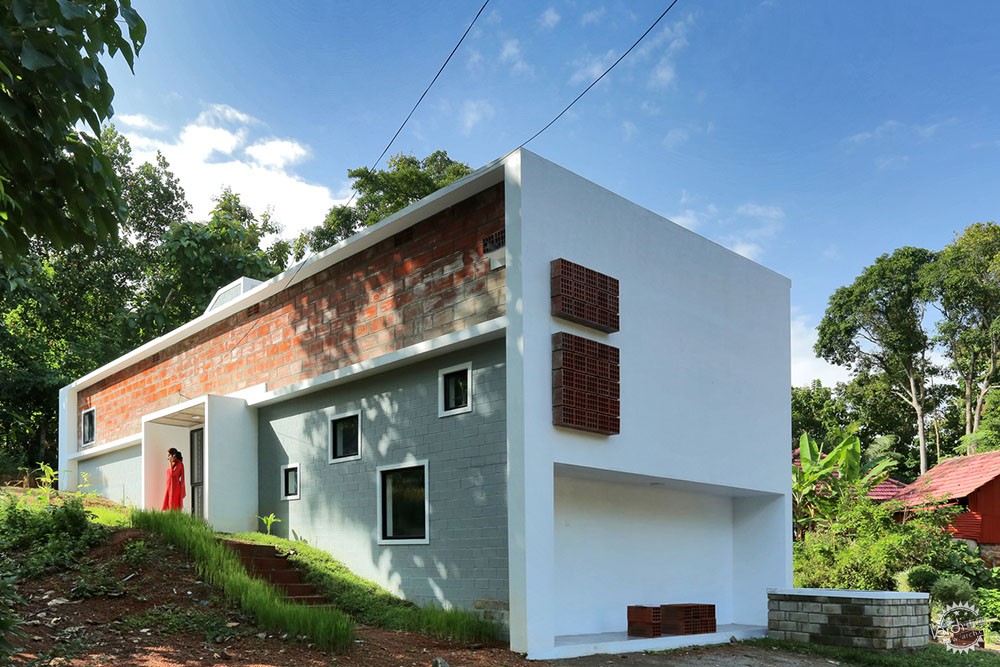
之间的住宅
A Home in Between / Ego Design Studio
由专筑网邢子,小R编译
来自建筑事务所的描述:项目位于温暖潮湿的热带气候环境中,场地是一块面积有限的坡地,这是为彩票销售商及其家庭设计的一所预算有限的住宅。该项目须以1,200,000印度卢比完成。每个家都是一座房子,但并非每座房子都是一个家。在当今的社会中,尽管人们无法完全理解所有人的想法,但在试图创造标准的过程中,建筑师却独创地为客户设计每个空间。该住宅拥有双重的设计解读,建筑师既为使用者定制专属空间,也让空间具有私密特征。
Text description provided by the architects. Designed as a small, but big home with a limited budget on a relatively small sloping site in a warm humid tropical climate, for a lottery seller, his wife and their 5 year old son, with a grandmother visiting regularly. The project had to be completed on a limited budget of 12,00,000 Indian Rupees. Every home is a house, but not every house is a home. In today’s society, despite our incapability to understand any human mind completely, in his attempt to create a mark, the architect dictatorially curates every space he designs for his client. The residence negotiates the dual existence of ownership, both by the architect in terms of his designed signature object, and by the user in terms of the intimate customized spaces where he can design how he uses them.
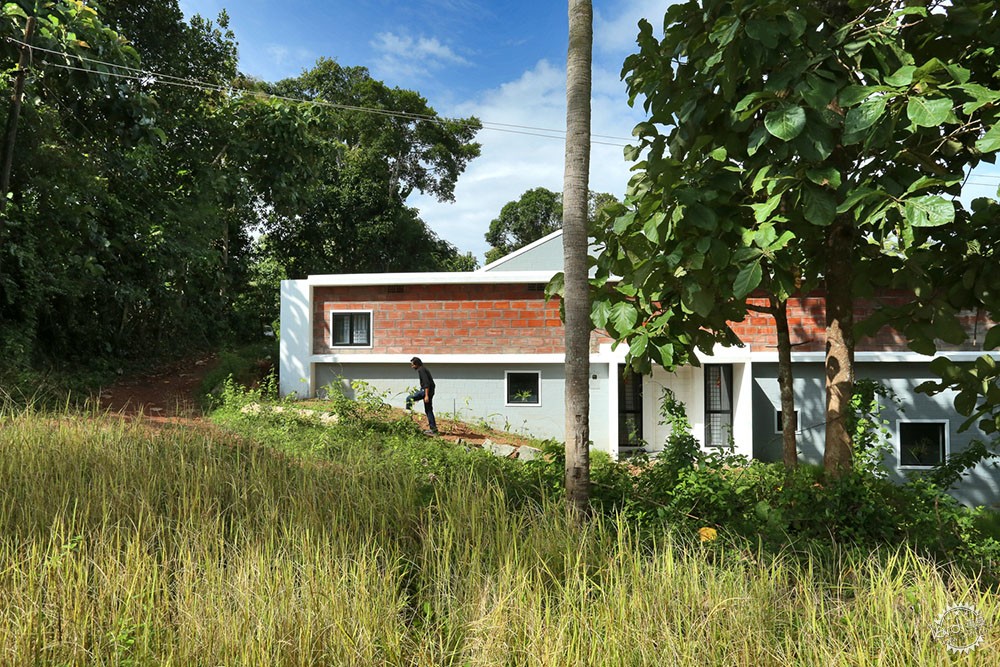
这是一种在家庭和住宅、用户和设计师之间进行协调的尝试,前者可容纳使用者的空间个性化和记忆特征,而后者则成为建筑师的设计标志。“介于之间的住宅”是Juhani Pallasm设计内涵的核心解读,是对亲密关系和住所的设计探索,重新定义了现代住宅设计的二元性,其中家庭和住宅的矛盾思想共存。多功能的内部装饰是一种空间属性,会随着时间的推移与住户进行转换,从而形成他们自己的“家庭”习惯。而住宅的外部形式则是可视化对象,具有个人主义色彩,同时与对场地边界的反应具有一定的相关性。
This is an attempted mediation between home and house, user and designer- the former accommodating the intimate spatial personalization and memory formation by the client, while the latter becomes the image, or signature, of the architect. The Content: ‘A home in between’ is a design exploration of Juhani Pallasma’s essay ‘Identity, Intimacy and Domicile,’ which explores the duality of a modern designed residence where the contradictory ideas of home and house try to coexist. A multi-functional interior is a spatial construct transforming over time with the user on a daily basis, thereby attaching to them on a personal note, forming their own idea of HOME. House: The exterior skin that engulfs the home is an imagery object, individualistic in formal character and contextual in its voidal response to the site boundaries.
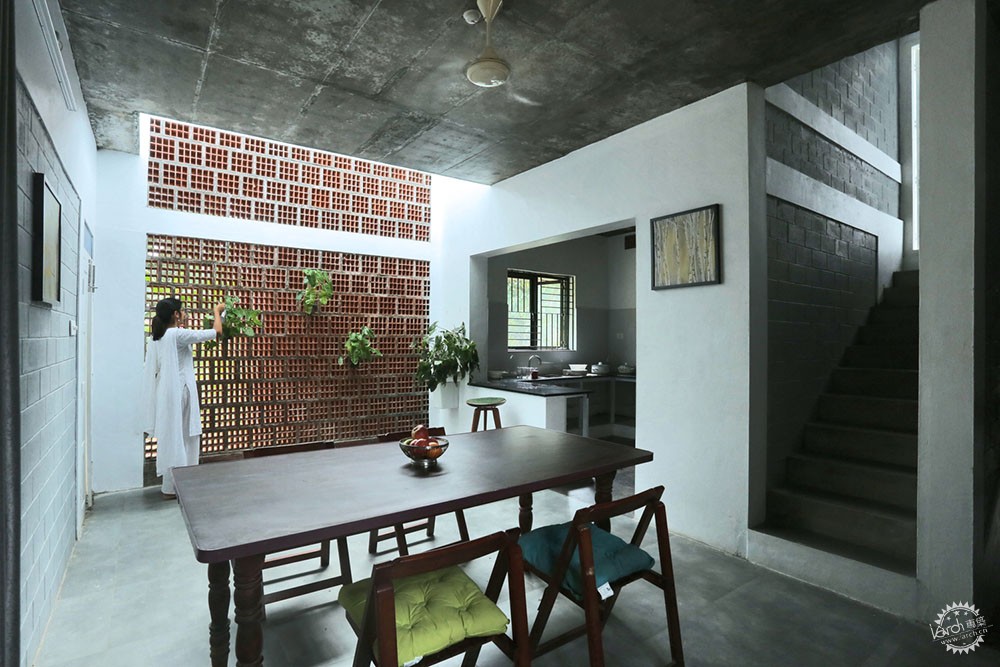
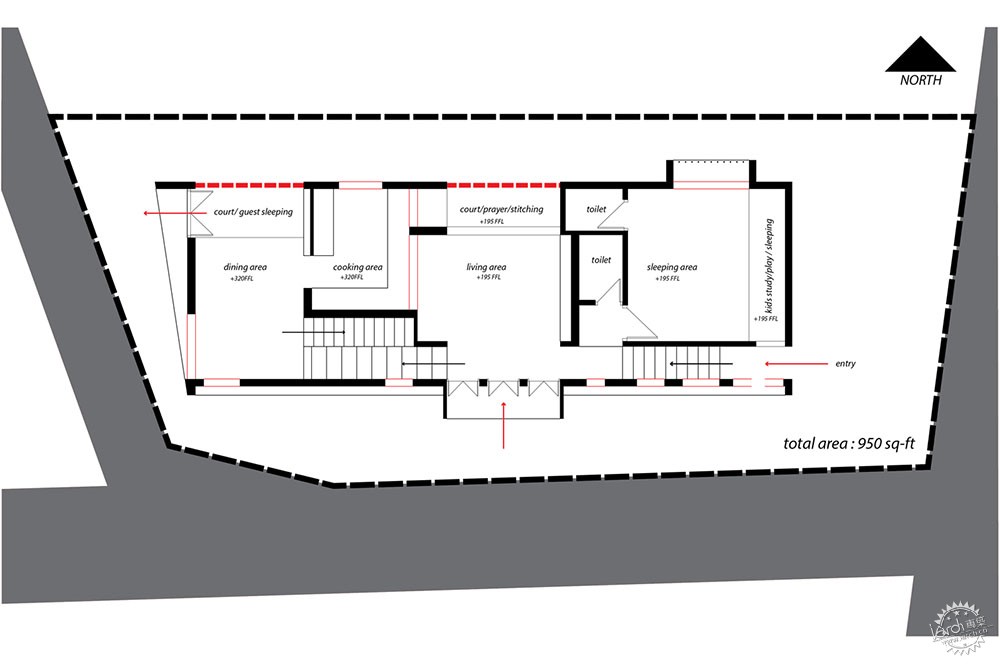
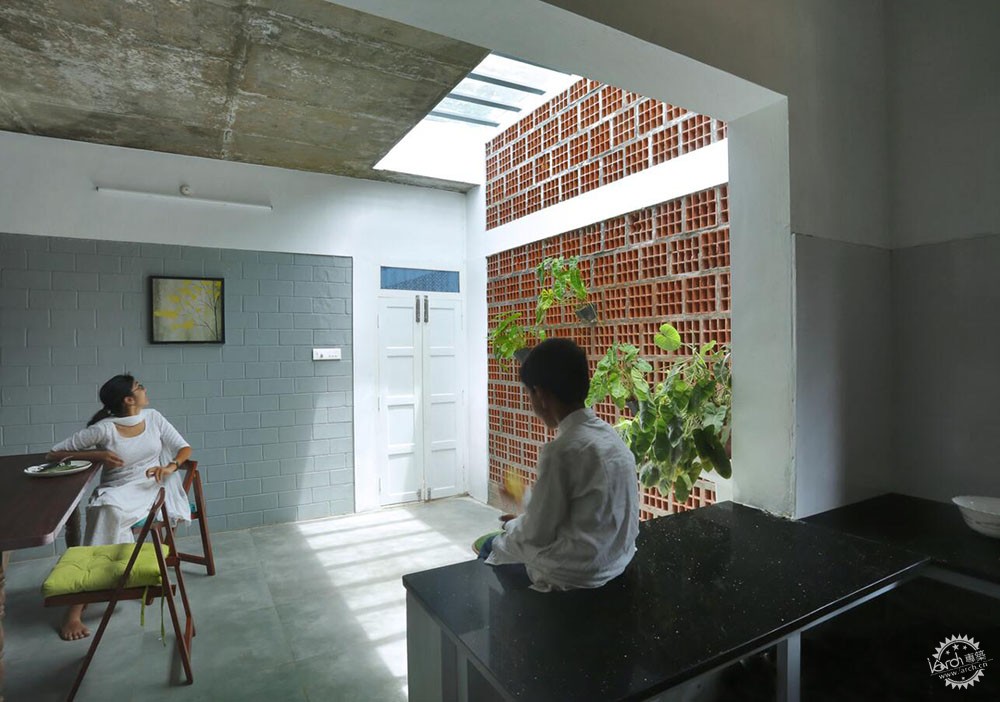
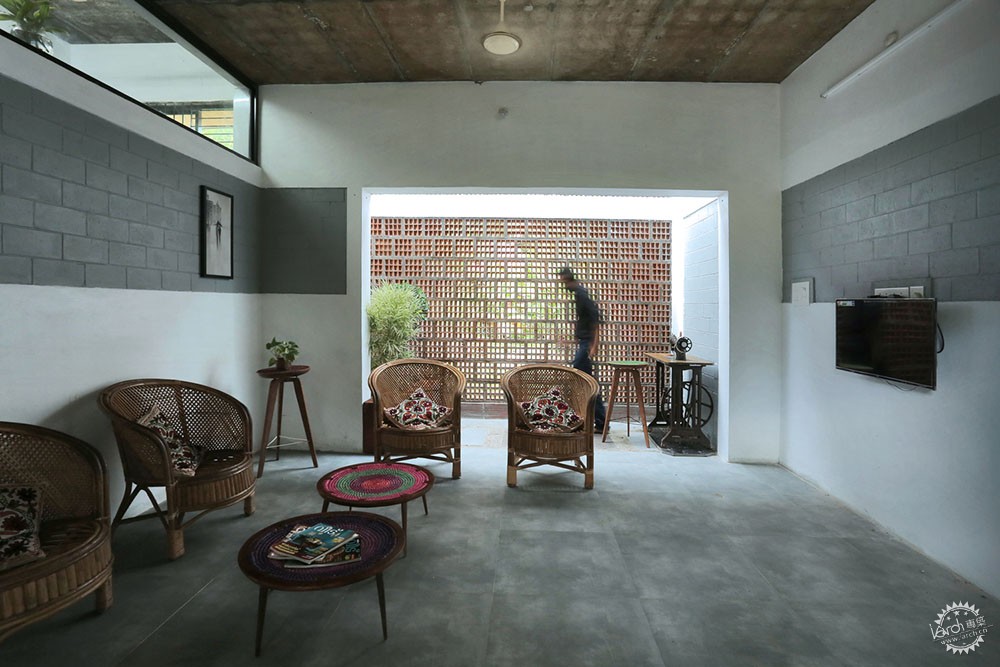
内部:该项目重新定义了当前空间数量重于空间质量的社会概念。在一个将房间数量视为大房子标准的社会中,这一尝试试图使每个空间活动和时间更加多元。内部主要活动空间旁有缓冲区,由阶梯通向走廊和球场,为住户提供了潜在的空间分配内容。在需要时可形成个人活动空间,并可扩大为家庭规模的较大空间。缓冲区是孩子可以适应活动的地方,使他能够建立自己对家庭的感知。这种个性化的设计在家庭记忆的形成中充当粘合剂,并加深了与空间的个人关联。
Interior: The project was an effort to redefine the popular social notion of quantity of space over quality of space. In a society, which considers number of rooms as a criterion of a big house, this one attempts to give each space activity & time based multiple existences. The inner primary activity spaces flanked by thermal & activity buffers- a level navigating step corridor & courts- offer potential spatial appropriation for the users. They form an individual’s personal activity space when needed, and enlarges into a larger spatial construct for the family when required. The buffer spaces are where the child can appropriate his activity niches, allowing him to build his own perception of HOME. This personalization acts as a binder in memory formation and increases personal association with the space.
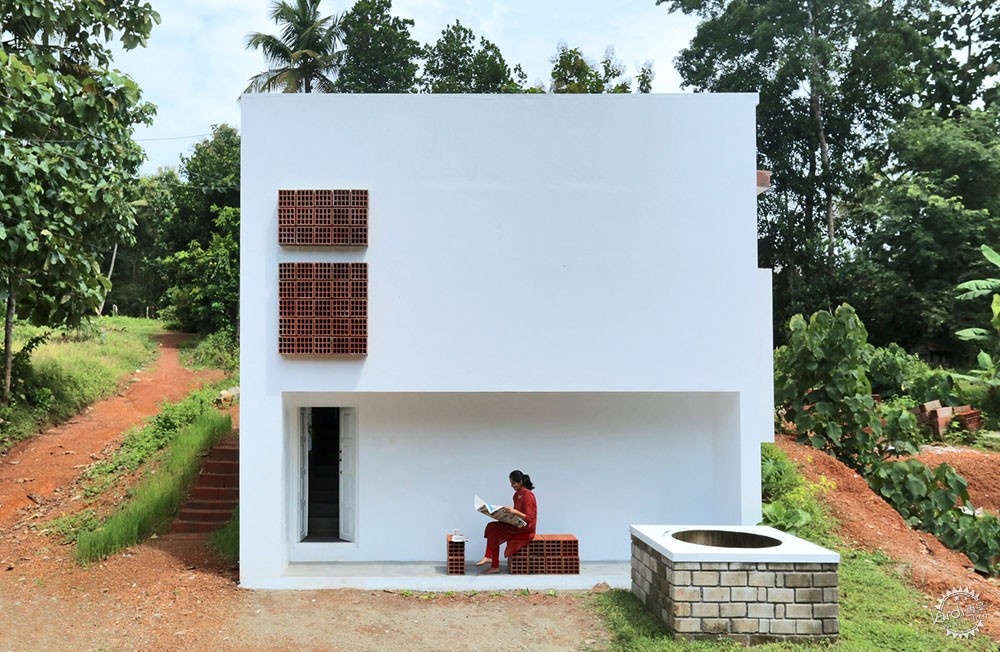
外部:是住宅的表皮,外立面是对附近边界条件和当地气候的真实反应。每个立面都通过其孔隙度对邻近区域做出反馈。南侧是农业用地,是可能保留数年的开放场地。从屋顶看去是交错的砖墙,砖墙上有特定的开口,这些开口在不同的水平上架起了平面,而大门也朝着同一方向开敞。北侧是一处空地,但之后可能会建造新的建筑,这将减少住宅的景观性及私密性,同时也将向住宅的墙壁反射热量。因此,整个北立面均由多孔陶瓷砖制成,在公共区域沿多孔结构排列,厨房和卧室采用带窗帘的窗户确保空间私密性。
Exterior: The skin, the exterior, the outer façade forming the HOUSE, is but responses to the nearby boundary conditions and the local climate. Each façade responds to the immediate neighborhood through its porosity. The south side is agricultural land which has the possibility of staying as an unaffected open area for a few more years. The overlooking facade is an interlock brick wall with specific openings framing the agricultural land at different levels and the main door opening to the same. Towards the north side lies a small vacant land with the proposal for a new building, which will reduce views/ privacy while also reflecting heat from the south facing walls. Hence the entire northern facade is made of porotherm brick, porous along the common areas and solid with curtained windows along the cooking and sleeping spaces.

面对车辆进出的主入口立面密不透风,只有一个侧门和通风的百叶窗。鲜明的白色墙体雕刻出一个空隙,在正立面上形成了微妙的阳台空间。朝西的后院被树木覆盖,有一个阳台和公共休息区,可通往果岭。这些墙壁形成了表皮和建筑形式的特征,内部功能合理,同时在周围的房屋中也有其特点,带有建筑师的设计风格。
Facing the main vehicular approach road, the frontage is the least porous face, with only a side entrance door and the ventilating porotherm jalley window. A void carved out of the stark white solid, creates a subtle verandah space recessed within the front façade. The west facing backyard being tree-covered has a large verandah and a common sitting space, opening to the greens. The frontage faces the vehicular road. The face is the least porous, with the side entry door and the ventilation porotherm jalley window. These walls form the skin and the identity of the built form, modest in its content, while strong in presence among the ornate houses around, bearing the architect’s designed signature.
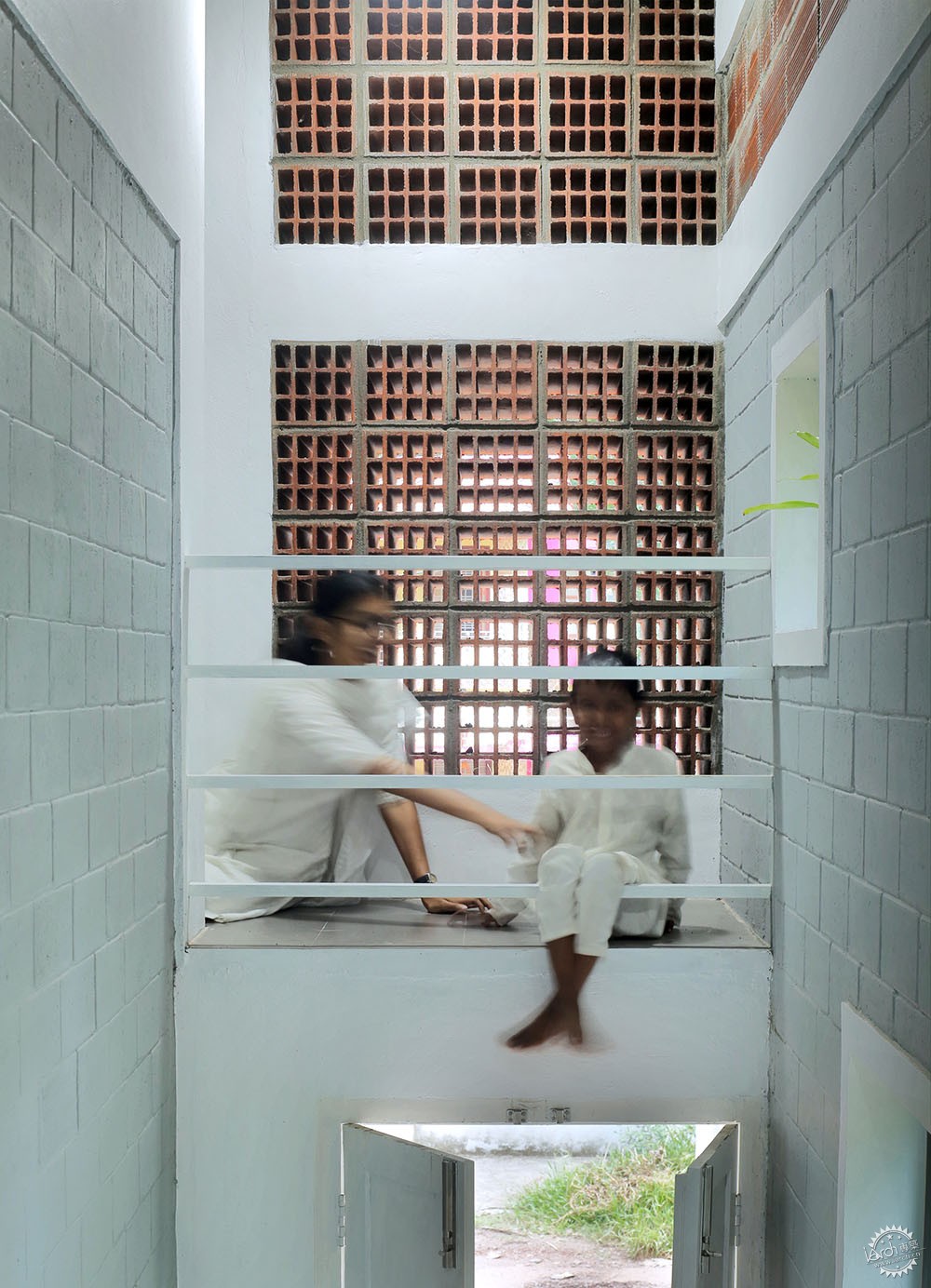

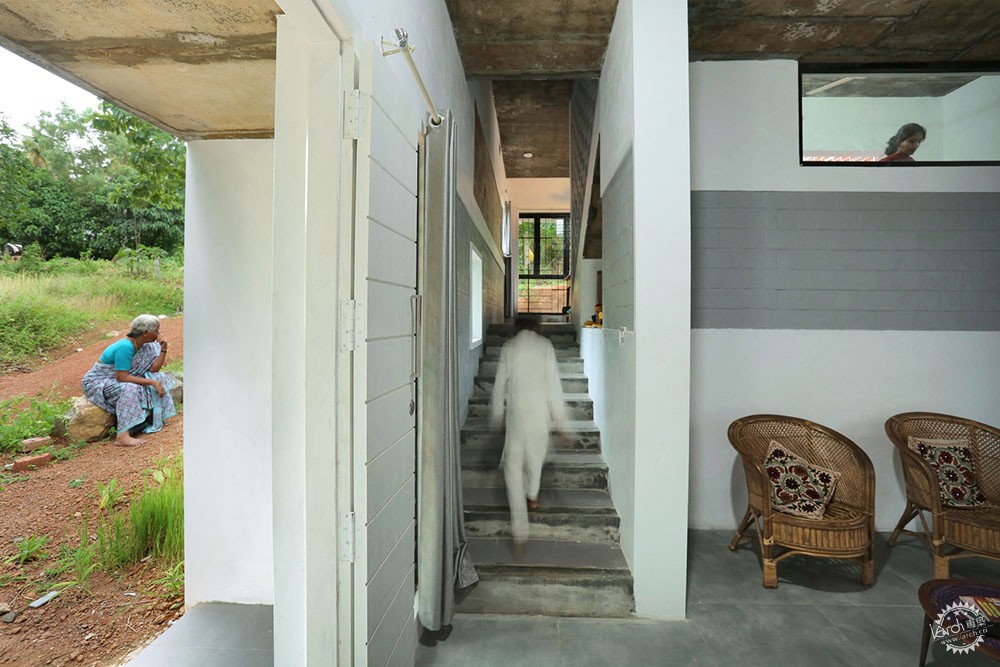
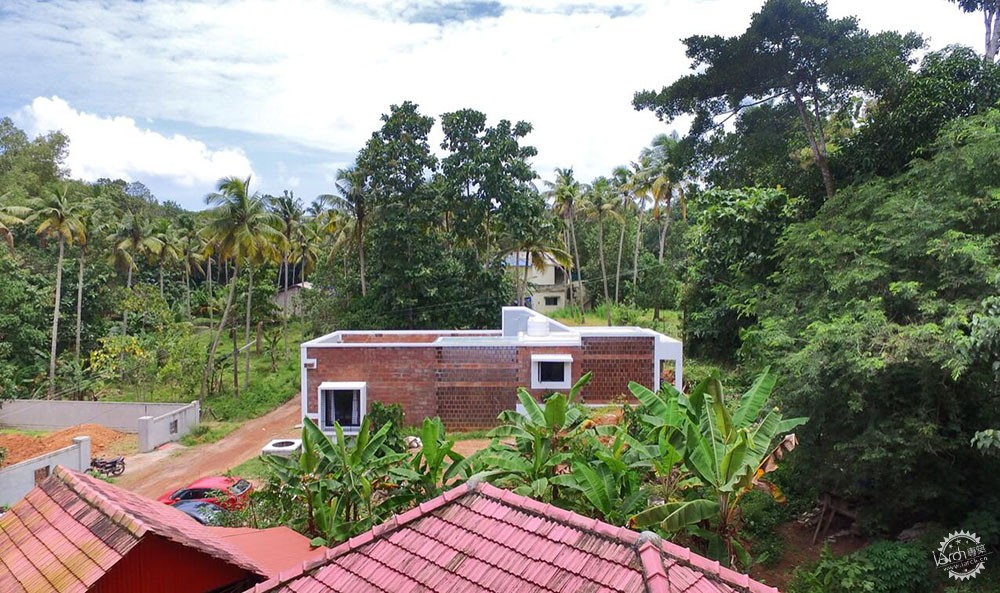
热舒适性:建筑沿东西向展开,主要开口分布在南侧和北侧,而其多孔的形式使风能在建筑中自由穿梭。由于使用多孔百叶窗、Weinerberger物料和热缓冲物质,住宅的内部温度比周围房屋低约5-7度。
材质:用于墙壁和百叶窗的隔热Porotherm砖,形成缓冲庭院的表皮,可以加强通风并对太阳光线进行热控制。当地的混凝土砌块用于砌筑剩余的墙壁,取材方便,可以直接运送到现场。
窗户:窗的大小由砖块大小决定,减少对砖的切割。
门:旧的木门从拆毁的房屋中取材,并重复使用。
门梁:由金属管铸成,不使用混凝土过梁。
Thermal Comfort: The built form is aligned along the East-West direction, with its longer sides with major openings facing North and South, while its porosity allows ample wind movement. The house has a temperature condition of about 5-7 degrees less than the surrounding houses due to usage of porous jalleys, weinerberger materiality & thermal buffers. Materiality: Walls Thermally insulated Porotherm bricks for walls and jalleys, forming the skin of buffer courtyards, allowing ventilation and cutting tropical sun for thermal control. Locally available concrete interlock blocks for remaining walls with a manufacturing unit nearby to be manually carried to site. Windows: Window sizes derived out of block sizes to avoid brick cutting. Doors: Old wooden doors were sourced and reused from demolished house. Lintels: Metal pipe lintels cut into the bricks to avoid concrete lintels.

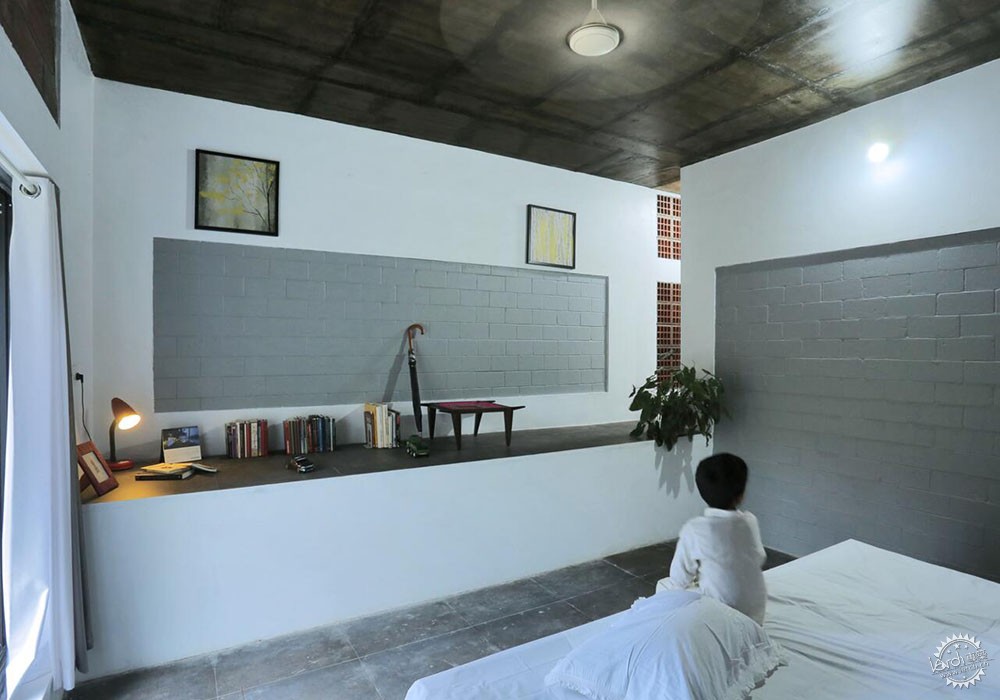


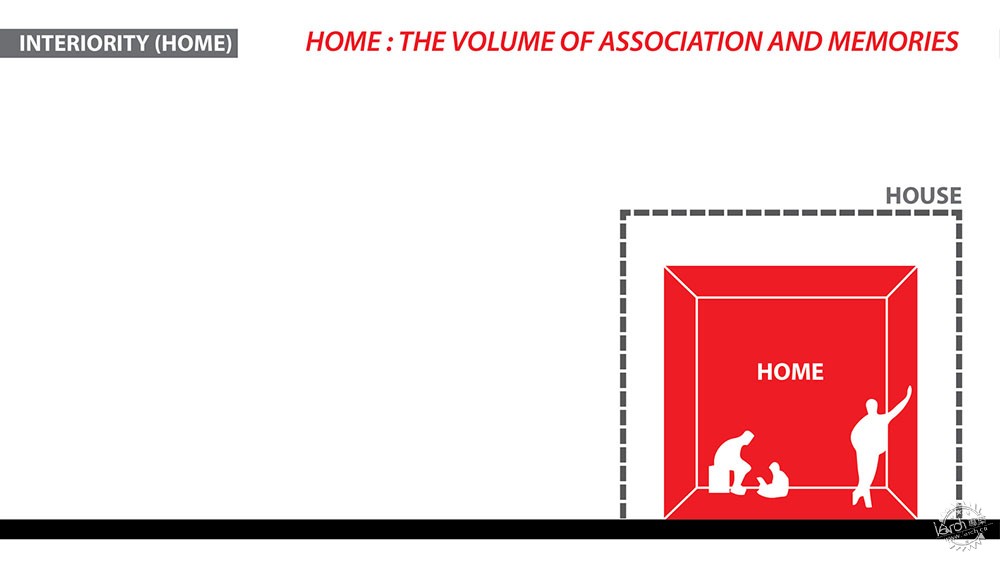

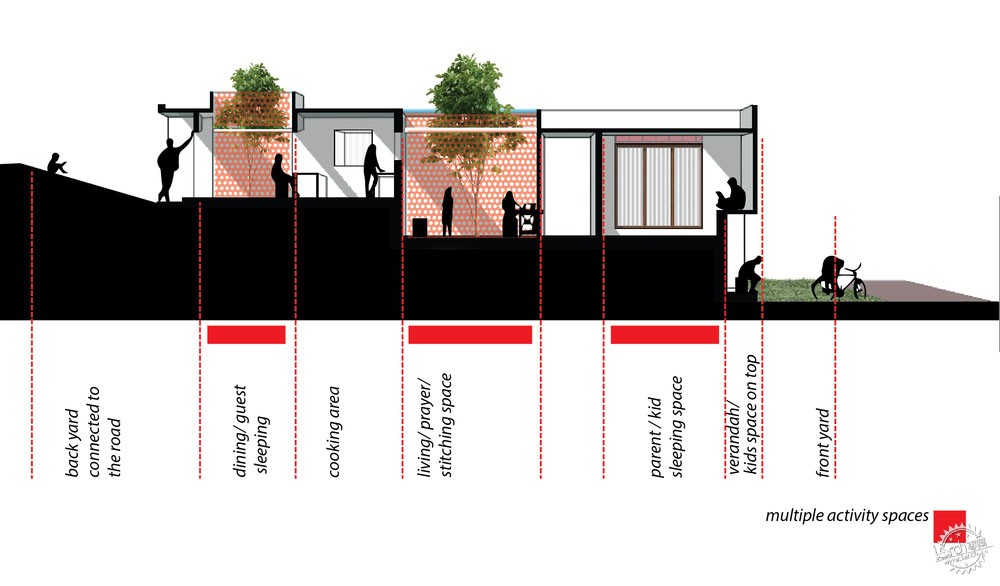
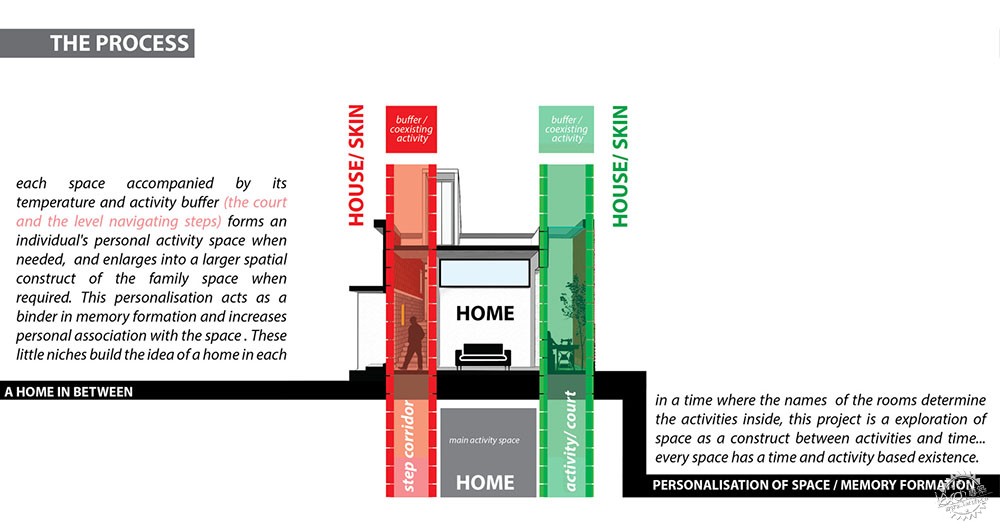
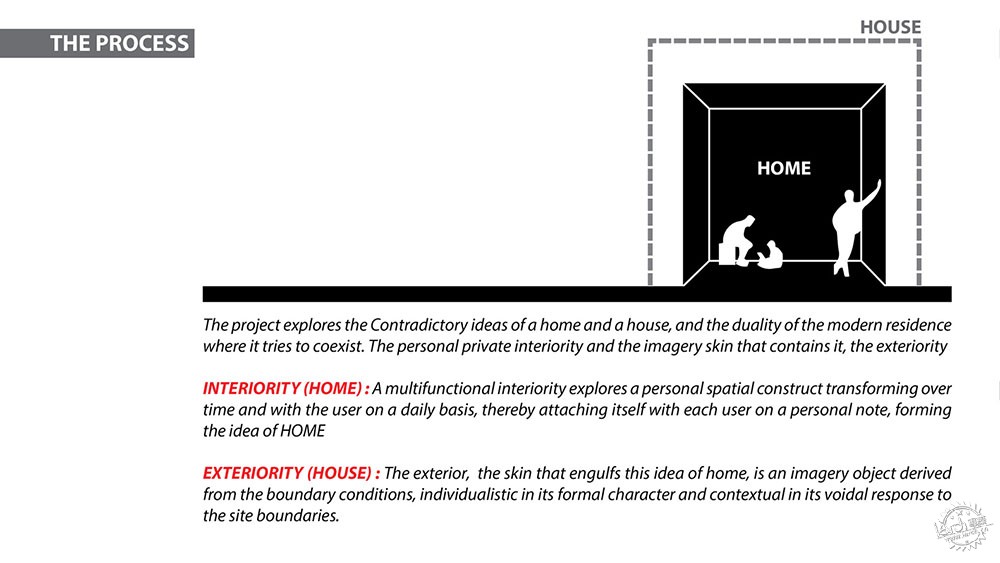
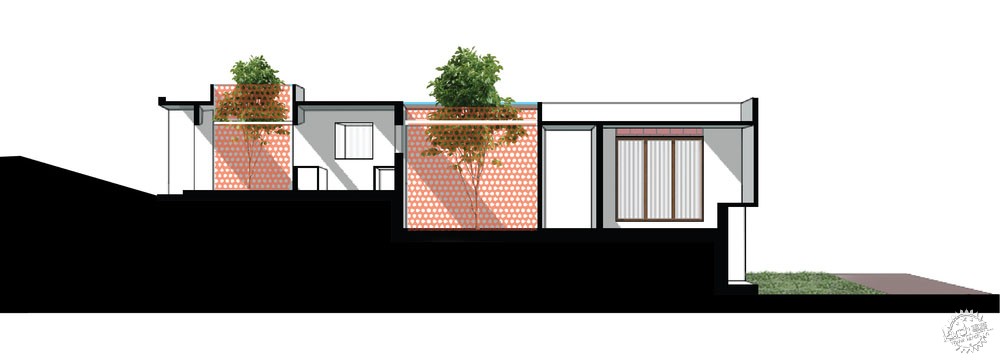
建筑设计:Ego Design Studio
地点:印度
类型:住宅
面积: 950.0平方英尺(约88.3平方米)
项目时间:2018年
摄影:Prasanth Mohan ( Running Studios)
制造商: Autodesk, Berger Paints, Build UP Building Material Industries, ProgeCAD, Restile, wienerberger india private limited
主创建筑师: Niranjan C Warrier,UABHIlash UA,Sudheesh S,Jerry Sam,Jayaram GS,Aravind T
设计团队: Anil Prasad,Dhanveer Ahmed,Arun Babu,
客户:Naveen Kumar & Nisha
工程: Krishna Gadha
景观: Aarati Binayak
Houses • Chathannoor, India
Architects: Ego Design Studio
Area: 950.0 ft2
Year: 2018
Photographs: Prasanth Mohan ( Running Studios)
Manufacturers: Autodesk, Berger Paints, Build UP Building Material Industries, ProgeCAD, Restile, wienerberger india private limited
Architect In Charge: Niranjan C Warrier, Abhilash U A, Sudheesh S, Jerry Sam, Jayaram G S, Aravind T
Design Team: Anil Prasad, Dhanveer Ahmed, Arun Babu,
Clients: Naveen Kumar & Nisha
Engineering : Krishna Gadha
Landscape: Aarati Binayak
|
|
